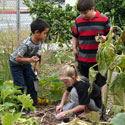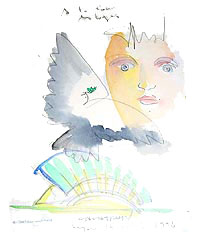kids
Other Things to Know I Learned from Kindergarten
Perhaps you’re familiar with the poem All I Really Need To Know I Learned In Kindergarten. It’s a classic of American infantilism, that innocence, heart, and “values” are more important than thinking. I’m all for the sharing and wonder celebrated in the original, but it’s notable the teachers are conspicuously absent. They are an invisible benevolent force, a manifestation of good-natured fairness guiding the core values of the room — not inappropriate for poem written by a minister. When power and authority are invisible, it makes sense that it all seems normal and natural.
I found this not to be the case. Having just put my daughter through Kindergarten, her first engagements with teachers and classroom discipline were hardly invisible. In fact, navigating power and order was a hallmark of the year. As such, it was interesting to draw out other lessons from the experiences of these little people engaged with a bureaucracy for the very first time. So here are other things to know I learned from Kindergarten:
- You can only speak when called on. But no one really hears you unless you speak out of turn.
- The ones who get the most attention are those who demand it.
- The authorities like best when you stay within the lines. It’s more fun when you don’t.
- Authorities will ruthlessly deny, redirect, defend, and cover up their mistakes.
- Rules are other people telling you what to do. The rules are arbitrary and subject to change without notice.
- Some people are not nice to play with. But your best friend may be the person you just happen to be sitting next to. You just don’t know it yet.
- Everyone is an artist.
 Mud teaches gardening on a massive scale — across the LA County Unified School District. He raises funds, de-paves urban lots, works with kids, teaches teachers, and Twitters it all. This guy is busy! So it seems appropriate that this interview takes place via Twitter.
Mud teaches gardening on a massive scale — across the LA County Unified School District. He raises funds, de-paves urban lots, works with kids, teaches teachers, and Twitters it all. This guy is busy! So it seems appropriate that this interview takes place via Twitter. “Do you want a salad with that?” A powerful NY Times infographic on how shifting the default parameters of a space can motivate changes in behavior, in this case quietly altering lunch line layout and interaction to nudge kids into making healthier lunch choices. The graphic does a good job of calling out key data, and the data is astonishing, but lacks citation or context so here’s an article and a longer report by the authors which covers the same material in more depth.
“Do you want a salad with that?” A powerful NY Times infographic on how shifting the default parameters of a space can motivate changes in behavior, in this case quietly altering lunch line layout and interaction to nudge kids into making healthier lunch choices. The graphic does a good job of calling out key data, and the data is astonishing, but lacks citation or context so here’s an article and a longer report by the authors which covers the same material in more depth.Think of the Children
In my bloggy readings, I keep finding stories of monuments and memorials sold on infantilism, using the lens of “childhood” to conjure an air of authenticity and gravitas.
 The New Yorker on Santiago Calatrava:
The New Yorker on Santiago Calatrava:
“In Liège, Belgium, Calatrava was one of seven contestants in an architectural competition to design a high-speed-train station. His rivals came in teams, armed with examples of their past work; Calatrava showed up alone, with his paintbrush [and watercolors], and won the commission. In January, 2004, while presenting his proposal for a new PATH transit hub for the World Trade Center site, Calatrava drew in chalk a child releasing a bird from her hands, thus conveying the genesis of the design, in which a pair of glass-and-steel canopies would arch over the sidewalks of lower Manhattan, like outstretched wings.”
The Washington Post on Ralph Appelbaum:
“When he took on the task of designing a presidential library for former Nigerian president Olusegun Obasanjo, for example, he proposed focusing the displays on the question, ‘What does it take to make a Nigerian child?’ It’s an unanswerable question, but it provided the necessary aha moment that made it all come together, a positive theme that finesses some of the philosophical problems of a presidential library in a country riven by corruption, violence, and religious, ethnic, linguistic and economic divisions.”
The Independent on Daniel Libeskind and his World Trade Center design:
“But Libeskind, a Polish American who now lives in Berlin, captured the hearts of New Yorkers when he appeared live on CNN during the final stages of the competition and said: ‘Like so many others, I arrived by ship in New York harbour as a teenager and as an immigrant. The Statue of Liberty and the Manhattan skyline made an unforgettable impression, and this scheme is all about that.’ ‘The minute he said that, he had the job,’ says Doris Saatchi, the New York art collector. ‘It’s not showmanship. He just expresses emotion so well.’”
Meanwhile, actual kids are moving adults to make responsible policy. See Democracy Now!: Testimony of 12-Year-Old with Two Moms Moves Some Vermont Legislators to Support Gay Marriage Bill.
The Vision Thing
An article of mine is running in the Design Issues column of the January/February 2008 Communication Arts. It started out as a piece about design education outside of traditional design schools, but then turned into something more — about grassroots engagement with public space and the power of design to envision change. Thanks Nicolas, Kim, Chris, David, and DK for their insight.
The Vision Thing
Seeing and creating change through design
It’s is not just in design schools. It’s not just in mentorship programs at top shelf firms. Design and education meet in the streets.
Most graphic design education points to a career as a design professional. But the same tools we use to undertake user research, solve problems, and satisfy clients can be used by young people to voice their opinions and meet the needs of their neighborhoods and communities.
The stories below are shining examples of design as populism. The designers of these projects – amateurs and professionals – have moved beyond a passive relationship to the world, beyond the daily pattern of serving clients, responding to assignments, and deadlines.
By taking it outside, they are asserting a positive vision and owning the spaces they live in – and in the process are making these places better for us all.
Human Traffic
Memorials shape our collective memory. They are a tangible, public stake against forgetting, a manifesto to the present and a reminder of the past as a warning for the future. Put forth by loved ones after a tragedy, grassroots memorials are at once both personal and public – often filling a void where government-funded memorials leave off. Some are subtle collections of flowers and personal items, occupying quiet corners of common space. Others scream out for attention. Rendered three-stories tall on the side of a building, the memorial mural on Butler Street and Third Avenue in Brooklyn is hard to ignore.
The design is a tribute to 28 pedestrians killed by cars between 1995 and 2007 in the streets of Brooklyn’s Gowanus neighborhood. The mural depicts three young boys, fifth-graders Victor Flores and Juan Estrada, and 4-year-old James Rice. All three were killed by cars speeding around corners – Rice was struck down just a block from the spot where the mural now stands. The driver who hit Rice got a ticket for failure to yield. Represented as towering figures painted in ghostly blue, the boys hold up redesigned streetsigns with traffic-related symbols urging respect for pedestrians. The three boys are accompanied by a blank silhouette holding up an unambiguous red stop sign declaring: “Not one more death.” The effect is chilling.

